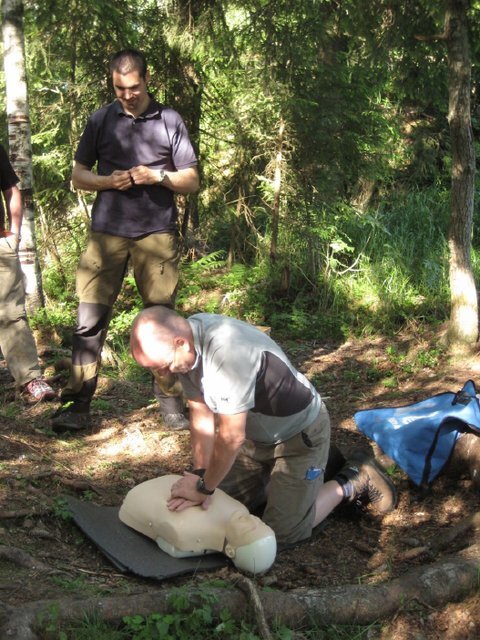16 hour DNT course in first aid
This article was originally published in Norwegian. You can read a machine translated version here.
16 hour DNT course in first aid, 4-5 June at Mustadkroken.
16 participants, as well as instructor David Rohrmüller, had a great weekend with well-arranged weather in relevant surroundings at Krokskogen.
The course is compulsory for DNT tour leaders, and the topic should be repeated from time to time, even for the most experienced. It is the case that this is knowledge that most of us do not use very often, but when it comes to it, it should be there.
The course was designed based on what most often goes wrong with people on a trip. With a good introduction to sensitive bodily functions and what the symptoms are when something fails. How we contact 113 - AMK, emergency medical [communications centre], both for guidance and clarifications, as well as possible assistance and transport from the site. Since we, as tour leaders, are most often outside the coverage area for mobile phones, we also received an introduction to how we can use/activate the emergency number. [We] then like to use the European emergency number, which is 112. In Norway, as you know, this goes to the police, [...]
As in primary school, we learned rules to make it easier to remember what we have to check, such as ABCDE; A irway, B reading, C irculation, D isability, E xposure.
We've all heard of open airways, and stable side lying no longer needs to be that stable, side lying is what's important, while stable is mostly for aesthetics. In cardiac compression, it is blood to the brain that is most important, so now there are 30 compressions and 2 breaths, this as corrected info for those who have learned it differently.
From Rema we have learned that "the simple is often the best". In relation to damage on the trip and cooling down, two plastic bags are easy to take with you and good to have. However, remember to cut a hole for the head, so that the patient receives oxygen.
Of the most likely events a tour leader can come across from illnesses on a tour are; Air lock, heart attack, convulsions, allergic reactions, temperature damage, sunstroke/burn, shock/circulatory failure, heat loss, wound damage, broken arm, crushing damage, internal bleeding etc. Everything was painstakingly reviewed with an explanation of symptoms.
On these topics, we simulated a rescue operation at the start of the course, as well as two operations at the end. Divided into three groups, everyone got to try their hand at the roles of support crew, markers and observers. Useful experiences after the model; look at, talk to, touch.
Thanks to DNT for a pleasant and educational weekend among colleagues. Thank you to the course leader and instructor David for good and relevant expertise, involvement by using subject expertise from the group, pedagogical presentation, and who, with his dialogue style and own expertise, ensured that the whole group sat engaged and upright in the heather.
Oslo 6 June 2011.
Ola Kleiven
Text: Ola Kleiven; Picture: Marcel Grohmann; Marker: Lene Virik Birkeland
Back


All comments are moderated before being published. Your email will not be visible